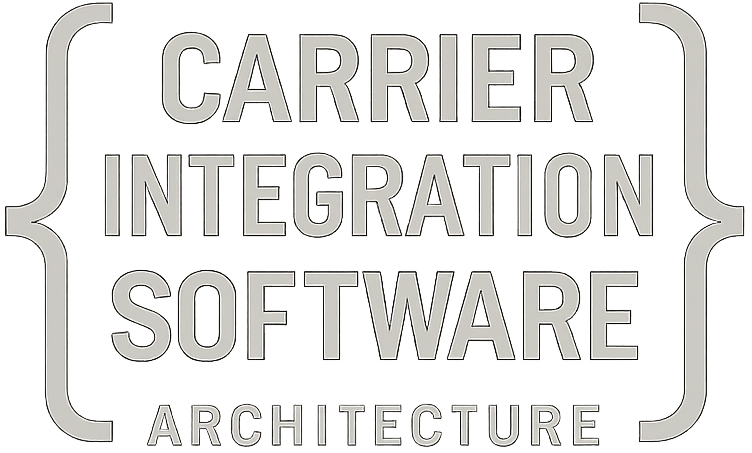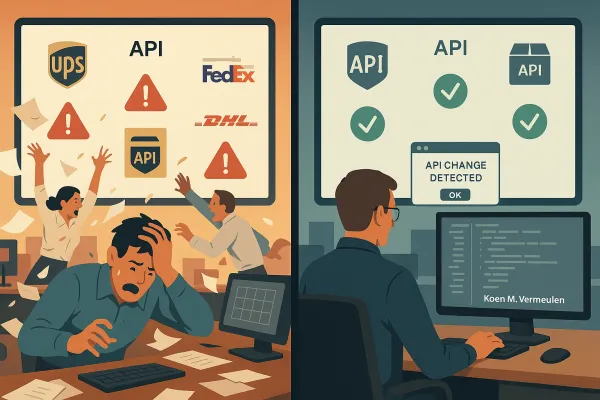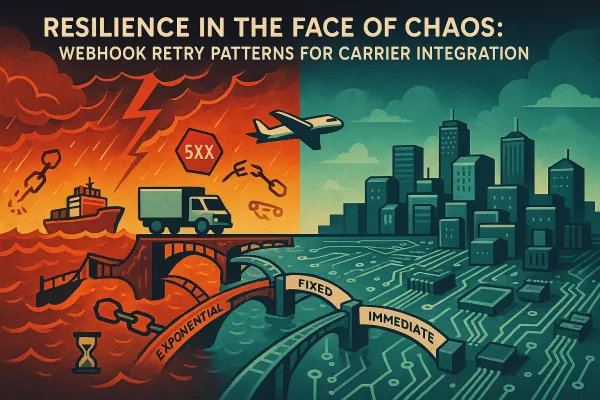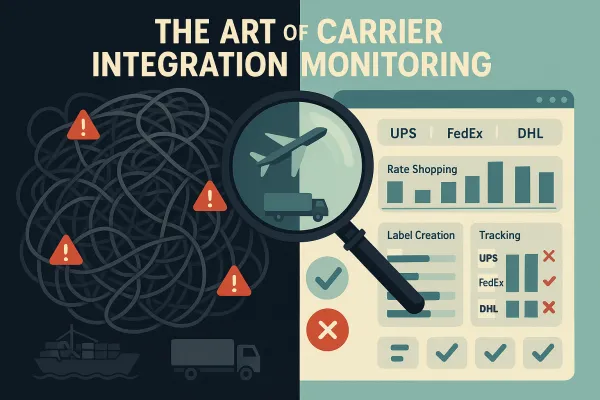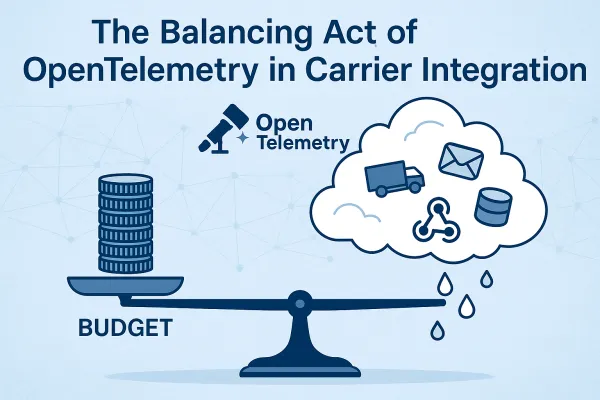Schema Evolution for Carrier Integration: Backwards-Compatible Migration from REST to AsyncAPI
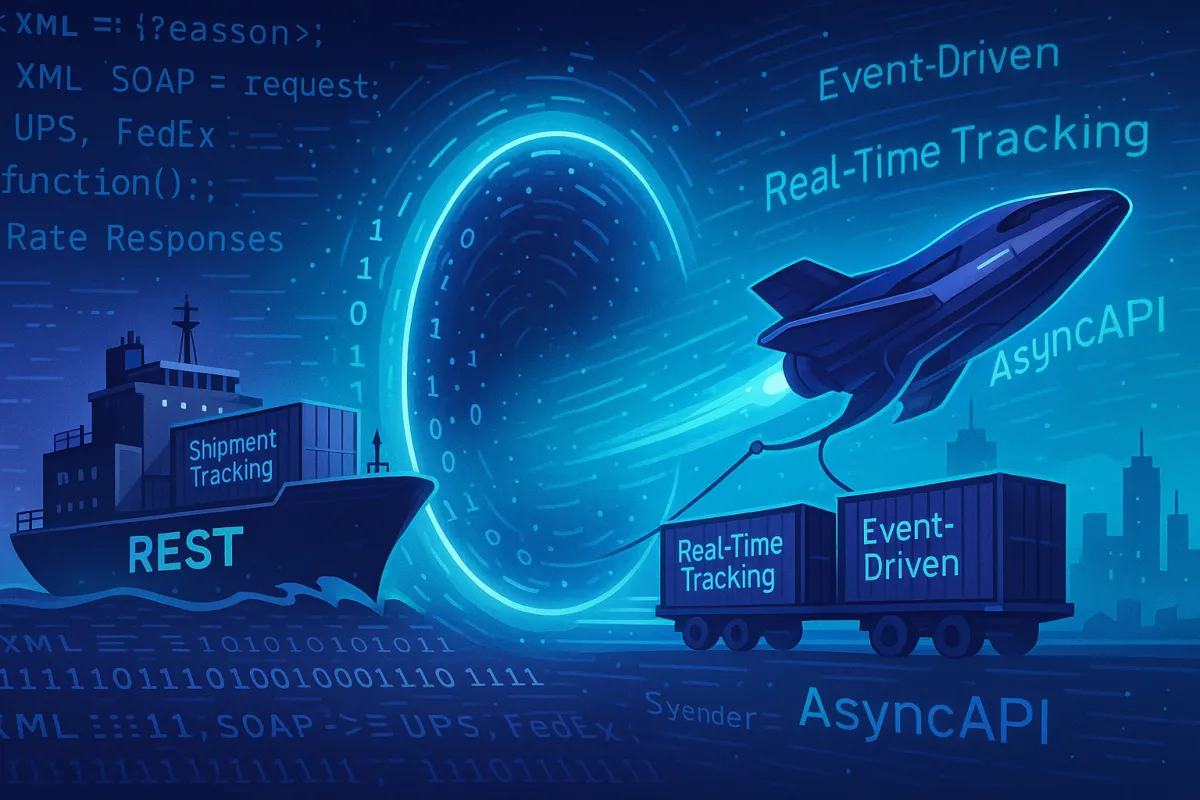
Major carriers are actively migrating away from SOAP-based APIs, with FedEx retiring their legacy Web Services in May 2024 and moving to RESTful APIs, while UPS transitioned from XML protocols to OAuth 2.0-secured REST endpoints. AsyncAPI has emerged as the industry standard for defining asynchronous APIs, creating a unique challenge for carrier integration platforms: how do you migrate schemas while maintaining backward compatibility across millions of daily transactions?
The pressure is real. Both FedEx and UPS had to extend their migration deadlines from May-June to August-September 2024, highlighting just how complex this transition has become for enterprise shippers. Many shipper companies still haven't realised that complying with new API access requirements isn't going to be quick or easy, and they can't wait until the last minute to begin upgrading.
Schema Compatibility: The Foundation You Can't Ignore
BACKWARD compatibility means consumers using the new schema can read data produced with the last schema - for example, if schemas change in order X-2, X-1, and X then backward compatibility ensures consumers using schema X can process data from producers using X or X-1. In carrier integration, this translates directly to your shipment tracking events, rate responses, and label payloads.
FORWARD compatibility means data produced with a new schema can be read by consumers using the last schema, ensuring data written by producers using the new schema X can be processed by consumers using schema X or X-1. This becomes critical when you're rolling out new AsyncAPI event streams while legacy REST consumers still need to function.
Here's where carriers create headaches: UPS might push a new tracking event format while your warehouse system expects the old structure. DHL updates their address validation schema, but your e-commerce platform won't see those changes for weeks. Schema versions where you only add or remove optional fields are forward and backward compatible, with FULL compatibility type checking the previous version or FULL_TRANSITIVE checking all previous versions.
The Confluent Schema Registry default compatibility type is BACKWARD, not BACKWARD_TRANSITIVE, mainly because it allows you to rewind consumers to the beginning of the topic. For carrier integration platforms processing millions of events daily, this rewind capability becomes essential when debugging rate calculation failures or tracking discrepancies.
REST-First to AsyncAPI: Migration Patterns That Actually Work
You can't flip a switch from REST to AsyncAPI. FedEx now offers a full suite of modern APIs alongside Advanced Integrated Visibility webhooks, demonstrating the hybrid approach most carriers are taking. The smart move? Run both protocols during your migration window.
Consider this dual-stack pattern: maintain your existing REST endpoints for rate shopping and label generation, while introducing AsyncAPI event streams for real-time tracking updates and delivery notifications. Platforms like Cargoson, nShift, and ShipEngine are implementing exactly this approach - REST for synchronous operations, AsyncAPI for event-driven workflows.
Request-Response Bridge Pattern
The asynchronous request-reply pattern becomes your friend here. When a rate shopping request comes through REST, you can publish an AsyncAPI event for downstream processing while still returning synchronous results. Your correlation ID management needs to work across both protocols - track REST API calls against AsyncAPI event responses using shipment references or transaction IDs.
Circuit breakers become essential at the protocol boundary. If your AsyncAPI message broker goes down, your REST endpoints should gracefully degrade to cached rates or direct carrier API calls. Don't let an event streaming failure take down synchronous operations.
Schema Registry Implementation for Multi-Protocol Environments
A schema registry such as Confluent Schema Registry or Apicurio Registry stores and validates schemas for topics and provides a REST API for producers and consumers. For carrier integration platforms, this means centralising both your JSON Schema definitions for REST endpoints and AsyncAPI specifications for event streams.
With FORWARD compatibility mode, you aren't guaranteed the ability to read old messages, and it's harder to work with because you need to anticipate all future changes. This is why most carrier integration platforms default to BACKWARD compatibility - you can always replay historical tracking events or rate calculations.
Multi-Format Schema Challenges
Carrier APIs present unique schema evolution challenges that generic compatibility rules don't address. Address formats vary dramatically across regions - a UK postcode schema won't validate German postal codes. Package dimension schemas need unit conversion logic embedded. Service code mappings evolve as carriers add new delivery options.
Currency and tax schemas create particular headaches during international shipping. Your schema registry needs to handle currency code additions, tax calculation formula changes, and duty schema modifications without breaking existing integrations. Consider versioning these domain-specific schemas separately from your core message envelopes.
Migration Sequencing: Who Upgrades First?
For BACKWARD compatible schemas, consumers have to be updated first to the new schema version. For FORWARD compatible changes, producers have to be updated first, while BACKWARD compatible changes require consumers to be updated first.
In practical carrier integration terms: if you're adding optional tracking event fields (backward compatible), upgrade your event processors before your carrier webhook handlers start sending new data. If you're removing deprecated rate calculation fields (forward compatible), upgrade your rate engines before updating downstream consumers.
This makes your schema evolution process easier, since consumers and producers can update independently when you maintain full compatibility. But carrier APIs don't always cooperate - sometimes FedEx pushes breaking changes that force coordinated upgrades across your entire integration stack.
Feature flagging becomes your safety net. Deploy AsyncAPI event handlers behind feature flags while keeping REST endpoints as fallbacks. Gradually shift traffic percentages as you validate schema compatibility in production. Platforms like Cargoson and Transporeon use this approach to minimize risk during carrier API transitions.
Blue-Green Deployment for Schema Changes
Schema changes in carrier integration platforms can't afford downtime. Blue-green deployments let you validate new AsyncAPI schema versions against production traffic without impacting live shipments. Run both schema versions in parallel, comparing results before switching traffic.
Monitor compatibility failures during migration using dedicated metrics. Track schema validation errors by carrier, message type, and compatibility mode. Alert on increases in dead letter queue messages - these often indicate schema drift between sandbox and production carrier APIs.
Edge Cases: When Compatibility Theory Meets Carrier Reality
Carriers don't always follow semantic versioning. DHL might change address validation rules without schema version updates. UPS could modify tracking event timing without updating AsyncAPI specifications. Sometimes we make incompatible changes, like modifying a field type from Number to String, requiring either upgrading all producers and consumers simultaneously, or creating a brand-new topic and migrating applications to the new schema.
IoT devices and mobile apps create compatibility lag. A driver's handheld scanner might run firmware that's months behind your latest schema changes. Plan for extended compatibility windows - BACKWARD_TRANSITIVE is the preferred compatibility mode for systems involving batch consumers, such as data lakes, but also for systems with slow-updating edge devices.
Streaming systems typically benefit from FORWARD_TRANSITIVE compatibility when consumers are highly decoupled from producers; if you do not own, control, or have the ability to influence the development life-cycle of your consumers then this is essential. This perfectly describes carrier integration platforms - you can't control when DHL updates their webhook payload format or when a shipper's TMS system gets upgraded.
Recovery and Observability
Dead letter queues become essential for handling incompatible messages during schema transitions. When FedEx sends a tracking event that doesn't validate against your AsyncAPI schema, capture it for manual processing rather than dropping it entirely. Include original message metadata, validation error details, and retry policies.
Schema validation metrics need carrier-specific dimensions. Track validation success rates by carrier (UPS, FedEx, DHL), message type (tracking, rating, labeling), and compatibility mode (backward, forward, full). Set alerting thresholds based on historical patterns - a 5% increase in validation failures might indicate an undocumented carrier API change.
Implement rollback automation with clear triggers. If schema validation error rates exceed thresholds, automatically revert to the previous schema version. But include manual override capabilities - sometimes you need to push through validation errors when carriers make emergency API changes without notice.
The migration from REST to AsyncAPI for carrier integration isn't just a technical upgrade - it's an operational transformation that requires careful schema evolution planning, multi-protocol architecture design, and robust observability. These API changes will make customers' and carriers' data much more secure, but they're making life considerably more complicated for shippers' IT departments in the short term. The platforms that master backward-compatible schema evolution will have significant advantages as the industry continues its shift toward event-driven architectures.
